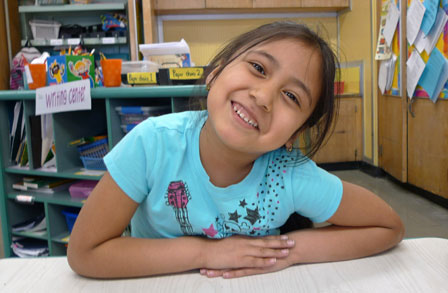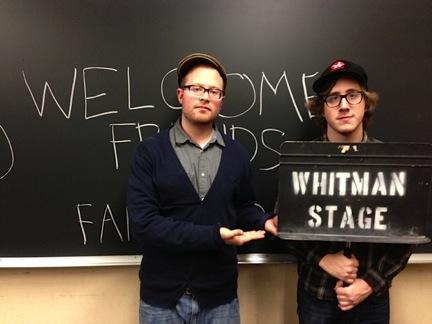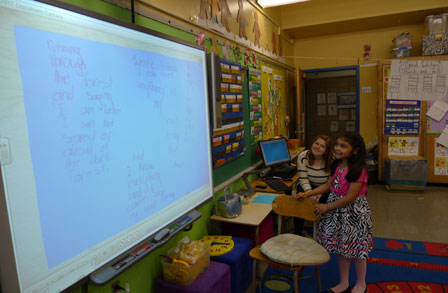Serious Play: Odes to the Everyday
What first-graders can teach college students.

In play we move below the level of the serious,
as the child does; but we can also move above it—
in the realm of the beautiful and the sacred.
—Johan Huizinga, Homo Ludens
When people hear that I teach poetry writing to both college students and early elementary school kids, they often ask, “What is that like?” They rightfully assume that these two experiences are different—and in many respects, they are right. The kids have active imaginations, but they lack a large vocabulary and many struggle with basic mechanics. The college students have more ideas, more memories, and more words, but when you ask them to write a poem, they tend to resist or stiffen. They want their writing to make sense, or to sound a certain way, or they have their eye on a good grade. When the young ones write, they are less anxious about the result. They are in the moment, seeing where the pencil is leading them. They enter into the experience of creating something on the page that didn’t exist before, of discovering the movement of their minds, of the flights that happen when they have permission to play on the page.
I teach the first-graders weekly, and as you can imagine, they have their own challenges. Some of my students say each word aloud as they write, listening for the letters that correspond to the sounds. Others press a fingertip after a just-written word to create a space before the next one. At least once during every class, a child will look up at me with a big pleading face and ask me how to spell “cheetah” or “the” or “friend,” and I refuse to do this. I tell them to “sound it out,” and they look back at me with the tiniest roll of their eyes. Yet, in spite of these difficulties, these young poets write surprising, funny, imaginative poems week after week. I walk into the room and say, “Repeat after me: ‘I’m a poet / and I know it / I’ve got my whole life / to show it.’” They chant back in booming voices. I say, “Twist the invisible knob by your ear and turn on your imaginations,” and they take it a step further. Aengus’s fingers become blossoming eyelashes. Morgan shakes her shoulders like Janet Jackson. I read poems aloud and we talk about them, and often we write poems together on the board. Then I say, “Here, take this sheet of paper and go write a poem,” and they do it. They plunge into the adventure, and they take pleasure in the process of writing. Even before they have finished, most are eager to share what they have written. When I point out a vivid line, they beam. “How did you come up with that?” I ask. “I just wrote it,” they reply.

Needless to say, things are different in my college classes. I do not ask them to chant at the beginning of class. I rarely distribute colored paper, and they never hug my leg. I have never heard a college student say, “Yay! Mister Matthew is here!” when I walk into the room. On the contrary, they tend to greet me at the beginning of the semester with wary expressions—some students look downright hostile. But I have learned to distrust appearances. What I am seeing on their faces doesn’t match their inner desire to be there: to write poems, and to be in proximity to other people writing poems. The look on their faces has more to do with fear. Unlike the first-graders, they have read the red ink on the walls: their writing has been judged and found wanting, or they have been misunderstood, rejected, or overlooked. Still, they are here because poetry has moved them, and they want to be moved again.
One crucial difference between the children and the college students is that the younger poets really know how to play. They are good at it. I walk in the classroom with a circular green sticker on my forehead and call it my “third eye,” and within minutes, we’re all neon-eyed visionaries. This ability fades as we grow up. By about fourth grade, some students will decline the invitation, and if you walk into a sixth-grade class with said sticker, a few will give you the stink eye. Understandably, they are more skeptical. Because to enter into play is to enter into uncertainty. It involves letting go, and it involves the risk that in your looseness, in your un-self-conscious spontaneity, you may say or do something strange, something that someone could shame you for. Therein lies the risk, and therein lies our poetry. How could I get the college students to behave more like the children?

Eventually I started bringing stacks of first-grade poems to class at Brooklyn College. I read a few favorites aloud to my workshop, and even the most poker-faced students broke into smiles. Some accused me of lying—no way was this written by a six-year-old. Then I distributed children’s poems to the college students and asked them to read them aloud. While the mood persisted, I asked them to write. And it worked! The playfulness of the children’s poems infected my college students. They loosened up, took things less seriously, and remembered, if briefly, how to play. I became more and more convinced that play is really serious.
Increasingly I try to create the conditions within my college poetry workshops where play becomes possible. It is an ongoing experiment, but I have a few techniques that help:
- Whenever possible, sit in a circle. As simple as it sounds, the circle has a certain magic to it. When we play, we form a circle. We face each other; we’re all in.
- Make time for frequent low-stakes in-class writing. In my workshops, we write as a warm-up, or as a transition between discussions and workshops. When we write often, the pressure to perform is diminished, and if we don’t connect with one prompt, there is always another. We learn through practice that playfulness overcomes our resistance.
- Write with your students, and share. A circle of people writing at the same time creates a feeling of solidarity; if the teacher opts out, the energy shifts. At the end of the allotted time, I ask for volunteers to read aloud, and I challenge myself to read my own as well, especially when the writing is strange or odd or broken. Our missteps may inspire our students even more than our successes.
- Make the room a place where “failure” is interesting, even encouraged. I never require writers to read free writing aloud, and I never collect it. I repeatedly give them permission to wander, digress, or write gibberish for the full five minutes. How often is our most vivid writing waiting on the other side of some mess?
Apart from methods like these, how do we come up with prompts that inspire our students to be playful? I experiment with exercises that emphasize process over product, that challenge strict notions of authorship, and that nudge us out of our familiar style or mode and keep us on our toes. One exercise that continues to surprise me is based on a familiar old-faithful: odes to everyday things àla Pablo Neruda. I call these “Instant Odes.”
- Distribute and read one or two of Neruda’s elementary odes. (I especially like “Ode to My Cranium” and “Ode to My Suit.”)
- Discuss the poem with the class. Ask students to identify his use of alliteration, apostrophe, enjambment, metaphor, and simile.
- Brainstorm a list of possible subjects for our own odes. Ask students for ordinary things that we encounter in our daily lives (the subway, coffee, etc.).
- Pass out long sheets of yellow legal paper, and ask the students to write down a title of an ode they might like to compose: “Ode to ________” Ask them not to write their name on the page.
- Once the titles have been written, collect these sheets and shuffle them.
- Explain the rules: whichever title you receive, you write a poem on that subject. Write for approximately five minutes, keeping your pen moving for most of the time. Don’t stop to think—just write. Speak to the subject of your ode, describe it, compare it to other things, try to use a little alliteration, and break the lines.
- Redistribute the stack, and keep the last one for yourself.
- After the allotted time, once students begin to slow down and finish, give a one-minute warning.
- Collect these sheets (again, these are anonymous; no names on the pages). Redistribute the stack once again for a “read-around.”
- Give everyone a minute to practice, and then ask students to read the poem aloud, clearly, with a little oomph.
- When the reading is over, I ask students to type up their poems and post them on either Blackboard, a class blog, or a “reply-all” email list.
Again and again, I have listened with astonishment as students read these unrevised, just-written poems. They are far from perfect, of course, but there is an energy and a wit that sets them apart from previous student work. Here’s a poem by student Danny Santarsieri that’s just one example of the great writing that emerges from this exercise:
Ode to Balance
Where would I be without you?
I’d be falling falling falling
And when I finally pick myself back up
Where would I be then?
Falling falling falling
But, no, I am not talking about the intricate
dream work, fluid filled, fair dancing system
you’ve set up in my ears. No, not just that.
I’m talking about your hands—your hands
that hold me when I break a glass cup
and spill beer on a rug—it’s you who
holds me back, you that whispers, you that hushes.
You are a mother, and with your even song
you keep me from throwing
another cup against the wall, tearing at my hair,
and kicking a black hole in the drywall.
Yes, you are a mother, and my, are you everywhere!
You dance with gravity, play with math. You
live etched on the spirals of seashells.
You knew Leonardo! And you saved my life,
when I wrestled with my brother on
the roof. Did I ever
thank you, mother?
Why does the “Instant Ode” exercise work? In part, I credit Pablo Neruda’s example, but I think there are other forces at play. The anonymity of this assignment has something to do with it; not putting our name on the poem helps us to outwit the inner critic that threatens to hijack the process. Often, when we begin to write a poem, we immediately impose a standard upon it. The ego gets involved. But at the precise moment when this process might kick in, I collect the sheets. The students are caught off guard, and are probably a little irritated. When I give them a subject that they didn’t choose, the stakes become lower. It’s just a game. Our attachment to the product has been loosened, and we are back in the process where the magic happens. The speed and spontaneity of the exercise somehow tricks the student into writing in a voice that is native, embodied, and authentic rather than full of “I am writing a poem” stiffness. And, finally, we have the opportunity to hear the poems aloud in someone else’s voice. Because we don’t know who wrote the poems, we are less inclined to write a story in our minds about the author, and we listen more attentively to the words.

Recently, after we read our “Instant Odes” aloud, I asked my students to reflect on the exercise. What was it like writing them, and how did it feel to hear their poems in someone else’s voice? Most students responded enthusiastically, but Tiffany Clarke wasn’t having it. She boldly raised her hand and said she disliked hearing her poem in another’s voice. It didn’t sound the way she intended it. A small wave passed over the class: who had read Tiffany’s poem? But there was no way of knowing, so everyone shared a sliver of the indictment. I spoke briefly about the value of identifying our resistances, and then I assigned the homework: choose your own subject and write an ode for next week’s class.
At the beginning of the following meeting, I asked for volunteers to read their ode aloud before passing them forward. Tiffany raised her hand. She prefaced her poem by saying that she had told her sister what happened in last week’s class, and that her sister said she should loosen up. We all listened attentively as Tiffany taught us a lesson.
Ode to Letting Go
I try to write a poem
Don’t rhyme don’t think
But there’s too much in my head
Mind clogged up like a sink
So I try some yoga
Namaste and I’m done
But nothing has changed, now energized
And my mind’s on the run
So now what do I do?
I know, say words that don’t make sense
Leaner loins lunchmeat Lakers la la la
But it irks me to sound so jumbled
And I need a massage cause
Now my shoulders are tense
I don’t know why letting go
Has to be so hard
And I want to apologize
But for this there’s no card
No “I’m sorry I’m so stiff”
One Hallmark never made
So I hope with time my joints will loosen
And this too will fade
Like a tree, branches straight as drawn arrows, the handle of a bow
All the wondrous powers of letting it all
Go
Hearing Tiffany read this poem aloud with a detectable tremble in her voice reminded me how courageous students can be in challenging their inner resistance. As teachers, we shouldn’t be surprised if they balk at our earliest invitations to play, and we shouldn’t give up too quickly or misread their reluctance as refusal.
* * *
Last Friday, the first-graders wrote poems about “feelings.” As we finished our collaborative poem on the board, Isaiah was glowing: wide eyes, illuminated face, and brimming with ideas. I handed him a sheet of paper, and he rushed from carpet to desk to get started. The title of his poem: “Bravery.” But when Isaiah reached the end of his first sentence, he stopped. I was helping a student one table away, but I kept an eye on him. He raised his hand to ask his teacher how to spell the word “cheetah,” and she gave him our usual line: sound it out. Five minutes later, while other papers filled with lines, Isaiah was still stuck: staring into space, still at the end of his first line.
“Don’t worry about spelling, Isaiah. Just sound it out. We can fix it later.” He looked back at me, and I could see that he was processing what I was saying, but he wasn’t convinced. I continued: “You have these amazing ideas zooming around in your head, and they want to fly down through your pencil onto the page. But when you stop to worry about how to spell something perfectly, they get impatient and fly out your ears.” Something clicked—Isaiah began writing again—and when I circled back to his desk at the end of class, a gorgeous poem had arrived with—yes—several phonetic spellings. Cheeda. Halleluiah.
When I told the story to his teacher during the lunch period, she immediately explained that Isaiah’s mother was strict. She came to school on family days and was very involved in his education, but apparently she discouraged mistakes. To put it another way, she would call out Isaiah’s mistakes forcefully, believing this would prevent him from making the same mistake again. I flashed back to Isaiah’s face as I explained why he shouldn’t worry about spelling. I could see his eyes—vividly—sorting through the mixed messages. Of course, I had no way of knowing what he was thinking at the time. Still, he was teaching me. He was reminding me that we begin our writing lives with open minds and a sense of discovery. If we place too much emphasis on facts and correctness, we risk distancing ourselves from the creative impulse. One solution, I think, is to clearly distinguish the stages of the writing process from an early age, and to emphasize the differences between “drafting” and “editing.” We should encourage the former to be exuberant, exploratory, even messy, with the understanding that mistakes can be corrected later.

Some teacher once asked us to write a poem or a story or a letter, and we stared at the blank page and took the plunge. Then we passed it in and waited, and eventually it came back to us. (What did yours look like when you got it back?) Whether we grew accustomed to praise or seemingly endless red edits, eventually we learned that writing is difficult, and that to make the attempt is necessarily to make mistakes. If you were lucky, you had teachers who understood that so-called mistakes were an inevitable part of the process, who valued the emerging idea over the error on the surface. But whatever happens to us, we become more inhibited as we grow up. We get a bit tighter, a bit more apprehensive, and eventually the blank page may seem more of a prison than an open field. And we stand at the edge with wary expressions, inwardly awaiting invitations to play. Play loosens us up, allows us to make gestures that are native and authentic and maybe even strange because they are beyond the range of our usual movements. And play—like poetry—inspires an absorption, a heightened attention that resists heaviness, a freedom, a flow.
Perhaps Salvador Chavez, age six, says it best:
Poetry
Poetry is an orange
rolling firecracker
of Fourth of July
and watermelons
and explosions,
100 fairs and carnivals
and beaches.
Poetry is freedom.
Sometimes I say
to a poem, you are
the King of anything
and the poem said,
you made me be
ideas from dinosaurs
and I said, you
save things by change
and the poem said,
you can be me
by believing
with your spirit
and we both said,
Thank you.
Matthew Burgess is the author of Slippers for Elsewhere (UpSet Press, 2014), as well as several children's books, including Enormous Smallness: A Story of E. E. Cummings. He has been a poet-in-residence in New York City elementary schools through Teachers & Writers Collaborative since 2001, where he serves on the editorial board of Teachers & Writers Magazine. Burgess earned his PhD at the CUNY Graduate...


